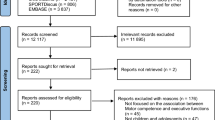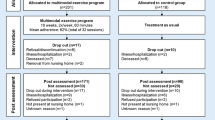Abstract
Purpose
Diagnosis of motor problems requires using reliable assessment tools. Movement Assessment Battery for Children—Second Edition (MABC-2) is one of the widely used tests in this area. The first objective of this study was to examine the psychometric properties of MABC-2 in the Iranian children's communities. The second objective was to compare the norm of the test with the performance of Iranian children to ensure its applicability in the Iranian community.
Method
Five hundred and three participants aged 7–10 years old were selected from ordinary schools and individually were evaluated using MABC-2. Psychometric properties were evaluated by calculating internal consistency (Cronbach alpha), test–retest and inter-rater reliability (Intra-Class Correlation) (N = 48), factor validity (Confirmatory factor analysis), and concurrent validity (Pearson correlation coefficient) by comparing MABC-2 to TGMD-2 (N = 57). We also used t-test to compare the norms of the two populations.
Results
Internal consistency was acceptable (0.64). Inter-rater and test–retest reliability of the total score was in a good and excellent range: 0.86 and 0.99, respectively. Fit indices confirmed the presumed 3-factor validity of the test without any additional adjustments (X2 = 18.29; df = 17; P value = 0.371; RMSEA = 0.012; NFI = 0.953; CFI = 0.996; AGFI = 0.981). The concurrent validity between both MABC-2 and TGMD2 tests was poor (0.31). Also, the results of the performance of the two populations showed significant differences, indicating the necessity of developing norms for the Iranian community.
Conclusion
Psychometric properties of the MABC-2 were confirmed. M-ABC-2 is also applicable in the Iranian community, but specific norms are required.

Similar content being viewed by others
Availability of data and materials
The data that support the findings of this study are available from the corresponding author upon reasonable request.
References:
American Psychiatric Association (2013) Diagnostic and statistical manual of mental disorders DSM, 5th edn. American Psychiatric Association, Arlington
Wann J (2007) Current approaches to intervention in children with developmental coordination disorder. Dev Med Child Neurol 49(6):405
Missiuna C et al (2008) Description of children identified by physicians as having developmental coordination disorder. Dev Med Child Neurol 50(11):839–844
Lingam R et al (2009) Prevalence of developmental coordination disorder using the DSM-IV at 7 years of age: A UK population–based study. Pediatrics 123(4):e693–e700
Wuang Y-P, Su J-H, Su C-Y (2012) Reliability and responsiveness of the movement assessment battery for children-second edition test in children with developmental coordination disorder. Dev Med Child Neurol 54(2):160–165
Schulz J et al (2011) Structural validity of the Movement ABC-2 test: factor structure comparisons across three age groups. Res Dev Disabil 32(4):1361–1369
Blank R et al (2019) International clinical practice recommendations on the definition, diagnosis, assessment, intervention, and psychosocial aspects of developmental coordination disorder. Dev Med Child Neurol 61(3):242–285
Niemeijer AS, van Waelvelde H, Smits-Engelsman BC (2015) Crossing the North Sea seems to make DCD disappear: cross-validation of Movement Assessment Battery for Children-2 norms. Hum Mov Sci 39:177–188
Henderson SE, Sugden DA, Barnett AL, (2007) Movement assessment battery for children-2: Movement ABC-2: Examiner's manual. Pearson
Zoia S et al (2019) An evaluation of the movement ABC-2 test for use in Italy: a comparison of data from Italy and the UK. Res Dev Disabil 84:43–56
Valentini NC, Ramalho MH, Oliveira MA (2014) Movement assessment battery for children-2: translation, reliability, and validity for Brazilian children. Res Dev Disabil 35(3):733–740
Psotta R, Brom O (2016) Factorial structure of the movement assessment battery for children test—second edition in preschool children. Percept Mot Skills 123(3):702–716
Kita Y et al (2016) Applicability of the movement assessment battery for children-to Japanese children: a study of the age band 2. Brain Develop 38(8):706–713
Engel-Yeger B, Rosenblum S, Josman N (2010) Movement assessment battery for children (M-ABC): establishing construct validity for Israeli children. Res Dev Disabil 31(1):87–96
Ellinoudis T et al (2011) Reliability and validity of age band 1 of the movement assessment battery for children–second edition. Res Dev Disabil 32(3):1046–1051
Badami R et al (2015) Validity and reliability of movement assessment battery for children (M-ABC) in 6-year-old children of Isfahan City. J Sports Motor Dev Learn. 7(1):105–22
Brown T, Lalor A (2009) The Movement Assessment Battery for Children-Second Edition (MABC-2): a review and critique. Phys Occup Ther Pediatr 29(1):86–103
Holm I et al (2013) High intra- and inter-rater chance variation of the movement assessment battery for children 2, ageband 2. Res Dev Disabil 34(2):795–800
Bardid F et al (2015) Cross-cultural comparison of motor competence in children from Australia and Belgium. Front psychol. https://doi.org/10.3389/fpsyg.2015.00964
Chow SM et al (2006) The movement ABC: a cross-cultural comparison of preschool children from Hong Kong, Taiwan, and the USA. Adapt Phys Activ Q 23(1):31
Van Waelvelde H et al (2008) The movement assessment battery for children: similarities and differences between 4-and 5-year-old children from Flanders and the United States. Pediatr Phys Ther 20(1):30–38
Venetsanou F, Kambas A (2016) Motor proficiency in young children. SAGE Open 6(1):2158244015626226
Morley D et al (2015) Influences of gender and socioeconomic status on the motor proficiency of children in the UK. Hum Mov Sci 44:150–156
Junaid KA, Fellowes S (2006) Gender Differences in the Attainment of Motor Skills on the Movement Assessment Battery for Children. Phys Occup Ther Pediatr 26(1–2):5–11
Froemel K et al (2014) Secular trends in pupils’ assessments of physical education lessons in regard to their self-perception of physical fitness across the educational systems of Czech Republic and Poland. Eur Phys Educ Rev 20(2):145–164
Ulrich DA (2000) Test of gross motor development. Pro-ed, Austin
Vangeneugden T et al (2005) Applying concepts of generalizability theory on clinical trial data to investigate sources of variation and their impact on reliability. Biometrics 61(1):295–304
Portney LG, Watkins MP, (2009) Foundations of Clinical Research: applications to practice. Pearson/Prentice Hall
Meyers LS, Gamst G, Guarino AJ (2016) Applied multivariate research: design and interpretation. SAGE Publications, Thousand Oaks
Arbuckle JL, (2014) Amos 23.0 user's guide. Chicago, IL: IBM SPSS
Biancotto M. et al. (2017) Movement Assessment Battery for Children–Second Edition. Standardizzazione italiana
Chow SM, Henderson SE, Barnett AL (2001) The movement assessment battery for children: a comparison of 4-year-old to 6-year-old children from Hong Kong and the United States. Am J Occup Ther 55(1):55–61
Livesey D, Coleman R, Piek J (2007) Performance on the movement assessment battery for children by Australian 3-to 5-year-old children. Child Care Health Dev 33(6):713–719
Hua J et al (2013) Age band 1 of the movement assessment battery for children-second edition: exploring its usefulness in mainland China. Res Dev Disabil 34(2):801–808
Wagner MO et al (2011) Factorial validity of the movement assessment battery for children-2 (age band 2). Res Dev Disabil 32(2):674–680
Logan SW, Robinson LE, Getchell N (2011) The comparison of performances of preschool children on two motor assessments. Percept Mot Skills 113(3):715–723
Acknowledgements
The authors would like to thank all the testers, children, and the staff of the participating schools. Special acknowledgments are due to Ali Noshir and Susan Toofani for their contribution to the early part of the study.
Funding
The authors did not receive funds, grants, or other support from any organization for the submitted work.
Author information
Authors and Affiliations
Contributions
All authors provided concept/idea/research design. MO and MB provided data collection and administered the tests. MO and MB wrote the manuscript with support from HW. MO and AK analyzed the data. EA and AG provided project management as thesis supervisors. All authors discussed the results and commented on the manuscript. HW provided final manuscript review.
Corresponding author
Ethics declarations
Conflict of interest
The authors declared no potential conflicts of interest with respect to the research, authorship, and/or publication of this article.
Ethical Approval
All procedures performed in this study were in accordance with the ethical standards of the Islamic Azad University' research committee. This article does not contain any studies with animals performed by any of the authors.
Informed Consent
Informed consent was obtained from all individual participants included in the study.
Additional information
Publisher's Note
Springer Nature remains neutral with regard to jurisdictional claims in published maps and institutional affiliations.
Rights and permissions
Springer Nature or its licensor (e.g. a society or other partner) holds exclusive rights to this article under a publishing agreement with the author(s) or other rightsholder(s); author self-archiving of the accepted manuscript version of this article is solely governed by the terms of such publishing agreement and applicable law.
About this article
Cite this article
Ojari, M., Bayatpour, M., Van Waelvelde, H. et al. Movement Assessment Battery for Children—Second Edition (MABC-2): psychometric properties for Iranian children (age band 2). Sport Sci Health 19, 1185–1192 (2023). https://doi.org/10.1007/s11332-023-01048-w
Received:
Accepted:
Published:
Issue Date:
DOI: https://doi.org/10.1007/s11332-023-01048-w




